2015 NISSAN GT-R warning
[x] Cancel search: warningPage 273 of 358
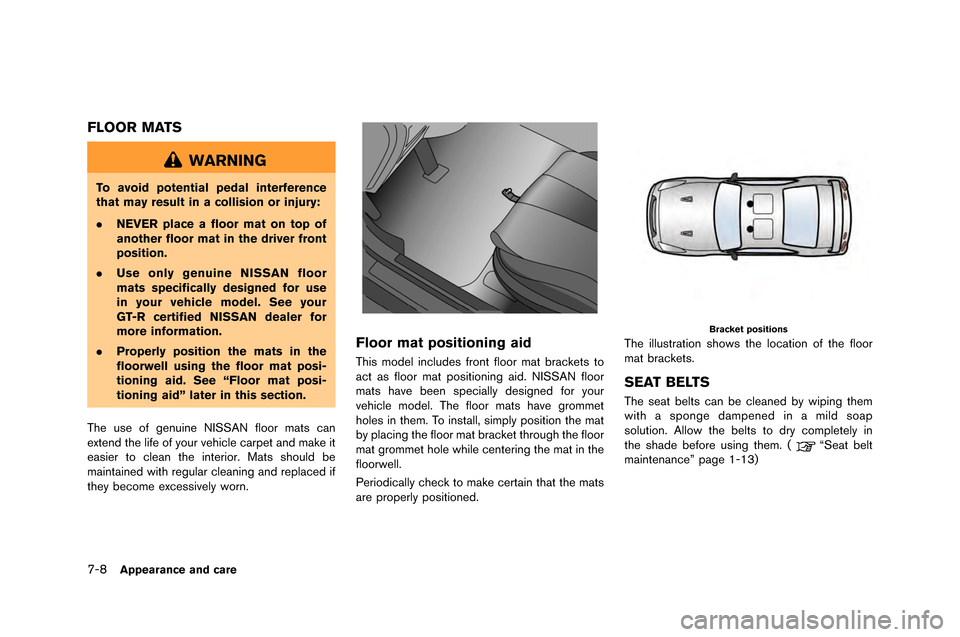
7-8Appearance and care
FLOOR MATS
WARNING
To avoid potential pedal interference
that may result in a collision or injury:
.NEVER place a floor mat on top of
another floor mat in the driver front
position.
. Use only genuine NISSAN floor
mats specifically designed for use
in your vehicle model. See your
GT-R certified NISSAN dealer for
more information.
. Properly position the mats in the
floorwell using the floor mat posi-
tioning aid. See “Floor mat posi-
tioning aid” later in this section.
The use of genuine NISSAN floor \fats can
e\btend the life of your vehicle carpet and \fake it
easier to clean the interior. Mats should be
\faintained with regular cleaning and replaced if
they beco\fe e\bcessively worn.
Floor mat positioning aid
This \fodel includes front floor \fat brackets to
act as floor \fat positioning aid. NISSAN floor
\fats have been specially designed for your
vehicle \fodel. The floor \fats have gro\f\fet
holes in the\f. To install, si\fply position the \fat
by placing the floor \fat bracket through the floor
\fat gro\f\fet hole while centering the \fat in the
floorwell.
Periodically check to \fake certain that the \fats
are properly positioned.
Bracket positions
The illustration shows the location of the floor
\fat brackets.
SEAT BELTS
The seat belts can be cleaned by wiping the\f
with a sponge da\fpened in a \fild soap
solution. Allow the belts to dry co\fpletely in
the shade before using the\f. (
“Seat belt
\faintenance” page 1-13)
Page 274 of 358
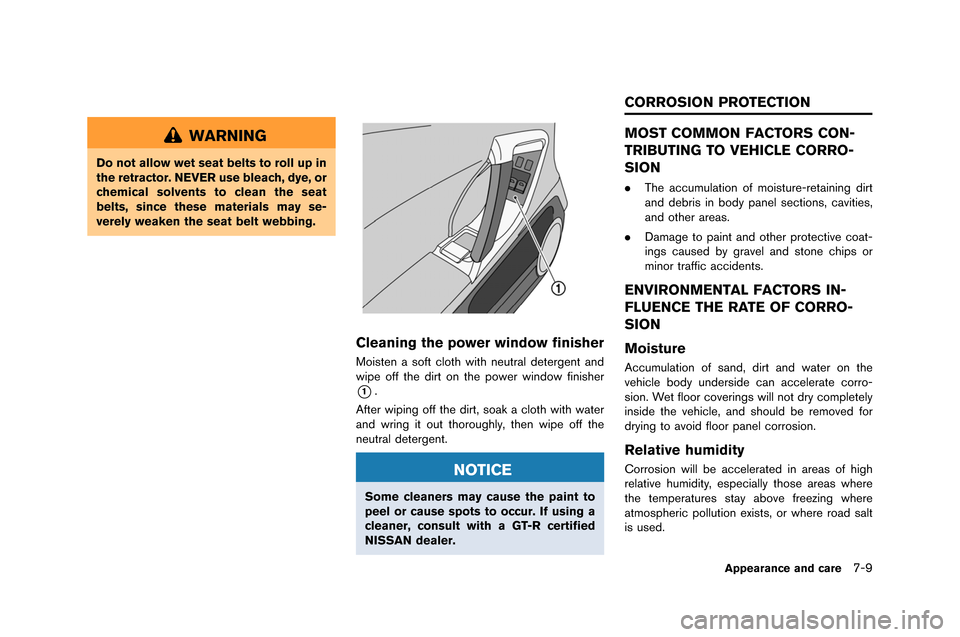
WARNING
Do not allow wet seat belts to roll up in
the retractor. NEVER use bleach, dye, or
chemical solvents to clean the seat
belts, since these materials may se-
verely weaken the seat belt webbing.
Cleaning the power window finisher
Moisten a soft cloth with neutral detergent and
wipe off the dirt on the power window finisher
*1.
\ffter wiping off the dirt, soak a cloth with water
and wring it out thoroughly, then wipe off the
neutral detergent.
NOTICE
Some cleaners may cause the paint to
peel or cause spots to occur. If using a
cleaner, consult with a GT-R certified
NISSAN dealer.
MOST COMMON FACTORS CON-
TRIBUTING TO VEHICLE CORRO-
SION
. \bhe accumulation of moisture-retaining\. dirt
and debris in body panel sections, cavities,
and other areas.
. Damage to paint and other protective coat-
ings caused by gravel and stone chips or
minor traffic accidents.
ENVIRONMENTAL FACTORS IN-
FLUENCE THE RATE OF CORRO-
SION
Moisture
\fccumulation of sand, dirt and water on the
vehicle body underside can accelerate corro-
sion. Wet floor coverings will not dry completely
inside the vehicle, and should be removed for
drying to avoid floor panel corrosion.
Relative humidity
Corrosion will be accelerated in areas of high
relative humidity, especially those areas where
the temperatures stay above freezing where
atmospheric pollution exists, or where road salt
is used.
Appearance and care7-9
CORROSION PROTECTION
Page 276 of 358
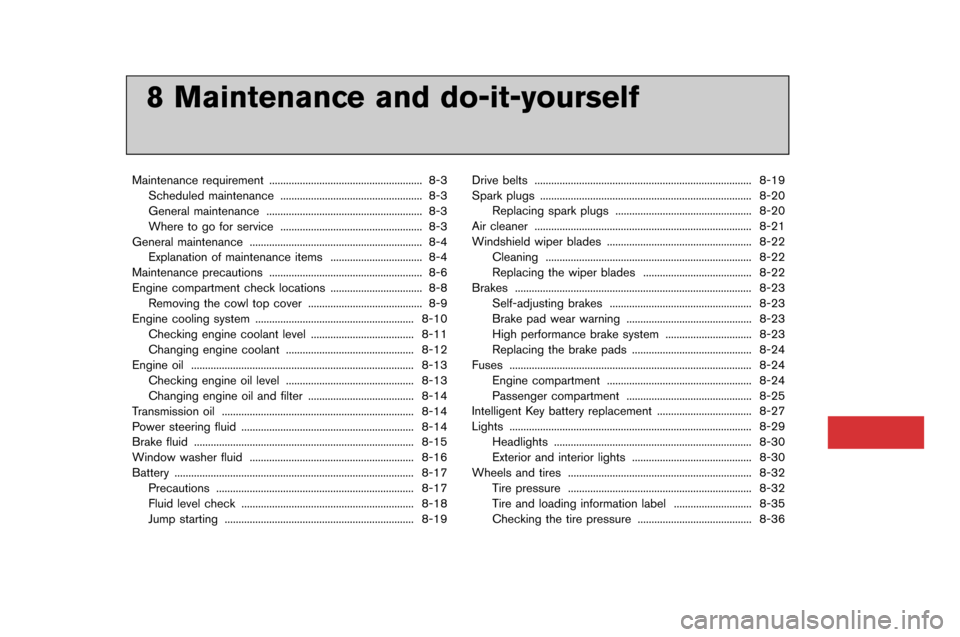
8 Maintenance and do-it-yourself
Maintenance requirement..................�l..................�l..................�l. 8-3
Scheduled maintenance ..................�l..................�l............... 8-3
�feneral maintenance ..................�l..................�l..................�l.. 8-3
Where to go �bor service ..................�l..................�l............... 8-3
�feneral maintenance ..................�l..................�l..................�l........ 8-4 Explanation o�b maintenance items ..................�l............... 8-4
Maintenance precautions ..................�l..................�l..................�l. 8-6
Engine compartment check locations ..................�l............... 8-8 Removing the cowl top cover ..................�l..................�l..... 8-9
Engine cooling system ..................�l..................�l..................�l... 8-10
Checking engine coolant level ..................�l..................�l. 8-11
Changing engine coolant ..................�l..................�l.......... 8-12
Engine oil ..................�l..................�l..................�l..................�l........ 8-13
Checking engine oil level ..................�l..................�l.......... 8-13
Changing engine oil and �bilter ..................�l..................�l.. 8-14
Transmission oil ..................�l..................�l..................�l............... 8-14
Power steering �bluid ..................�l..................�l..................�l........ 8-14
Brake �bluid ..................�l..................�l..................�l..................�l....... 8-15
Window washer �bluid ..................�l..................�l..................�l..... 8-16
Battery ..................�l..................�l..................�l..................�l.............. 8-17
Precautions ..................�l..................�l..................�l................. 8-17
Fluid level check ..................�l..................�l..................�l........ 8-18
Jump starting ..................�l..................�l..................�l.............. 8-19 Drive belts ..................�l..................�l..................�l..................�l...... 8-19
Spark plugs ..................�l..................�l..................�l..................�l.... 8-20
Replacing spark plugs ..................�l..................�l............. 8-20
Air cleaner ..................�l..................�l..................�l..................�l...... 8-21
Windshield wiper blades ..................�l..................�l................ 8-22 Cleaning ..................�l..................�l..................�l..................�l.. 8-22
Replacing the wiper blades ..................�l..................�l... 8-22
Brakes ..................�l..................�l..................�l..................�l............. 8-23 Sel�b-adjusting brakes ..................�l..................�l............... 8-23
Brake pad wear warning ..................�l..................�l......... 8-23
High per�bormance brake system ..................�l............. 8-23
Replacing the brake pads ..................�l..................�l....... 8-24
Fuses ..................�l..................�l..................�l..................�l............... 8-24
Engine compartment ..................�l..................�l................ 8-24
Passenger compartment ..................�l..................�l......... 8-25
Intelligent Key battery replacement ..................�l................ 8-27
Lights ..................�l..................�l..................�l..................�l............... 8-29 Headlights ..................�l..................�l..................�l................. 8-30
Exterior and interior lights ..................�l..................�l....... 8-30
Wheels and tires ..................�l..................�l..................�l............ 8-32
Tire pressure ..................�l..................�l..................�l............ 8-32
Tire and loading in�bormation label ..................�l.......... 8-35
Checking the tire pressure ..................�l..................�l..... 8-36
8 Maintenance and do-it-yourself
Maintenance requirement ..................�l..................�l..................�l. 8-3
Scheduled maintenance ..................�l..................�l............... 8-3
�feneral maintenance ..................�l..................�l..................�l.. 8-3
Where to go �bor service ..................�l..................�l............... 8-3
�feneral maintenance ..................�l..................�l..................�l........ 8-4 Explanation o�b maintenance items ..................�l............... 8-4
Maintenance precautions ..................�l..................�l..................�l. 8-6
Engine compartment check locations ..................�l............... 8-8 Removing the cowl top cover ..................�l..................�l..... 8-9
Engine cooling system ..................�l..................�l..................�l... 8-10
Checking engine coolant level ..................�l..................�l. 8-11
Changing engine coolant ..................�l..................�l.......... 8-12
Engine oil ..................�l..................�l..................�l..................�l........ 8-13
Checking engine oil level ..................�l..................�l.......... 8-13
Changing engine oil and �bilter ..................�l..................�l.. 8-14
Transmission oil ..................�l..................�l..................�l............... 8-14
Power steering �bluid ..................�l..................�l..................�l........ 8-14
Brake �bluid ..................�l..................�l..................�l..................�l....... 8-15
Window washer �bluid ..................�l..................�l..................�l..... 8-16
Battery ..................�l..................�l..................�l..................�l.............. 8-17
Precautions ..................�l..................�l..................�l................. 8-17
Fluid level check ..................�l..................�l..................�l........ 8-18
Jump starting ..................�l..................�l..................�l.............. 8-19 Drive belts ..................�l..................�l..................�l..................�l...... 8-19
Spark plugs ..................�l..................�l..................�l..................�l.... 8-20
Replacing spark plugs ..................�l..................�l............. 8-20
Air cleaner ..................�l..................�l..................�l..................�l...... 8-21
Windshield wiper blades ..................�l..................�l................ 8-22 Cleaning ..................�l..................�l..................�l..................�l.. 8-22
Replacing the wiper blades ..................�l..................�l... 8-22
Brakes ..................�l..................�l..................�l..................�l............. 8-23 Sel�b-adjusting brakes ..................�l..................�l............... 8-23
Brake pad wear warning ..................�l..................�l......... 8-23
High per�bormance brake system ..................�l............. 8-23
Replacing the brake pads ..................�l..................�l....... 8-24
Fuses ..................�l..................�l..................�l..................�l............... 8-24
Engine compartment ..................�l..................�l................ 8-24
Passenger compartment ..................�l..................�l......... 8-25
Intelligent Key battery replacement ..................�l................ 8-27
Lights ..................�l..................�l..................�l..................�l............... 8-29 Headlights ..................�l..................�l..................�l................. 8-30
Exterior and interior lights ..................�l..................�l....... 8-30
Wheels and tires ..................�l..................�l..................�l............ 8-32
Tire pressure ..................�l..................�l..................�l............ 8-32
Tire and loading in�bormation label ..................�l.......... 8-35
Checking the tire pressure ..................�l..................�l..... 8-36
Page 281 of 358
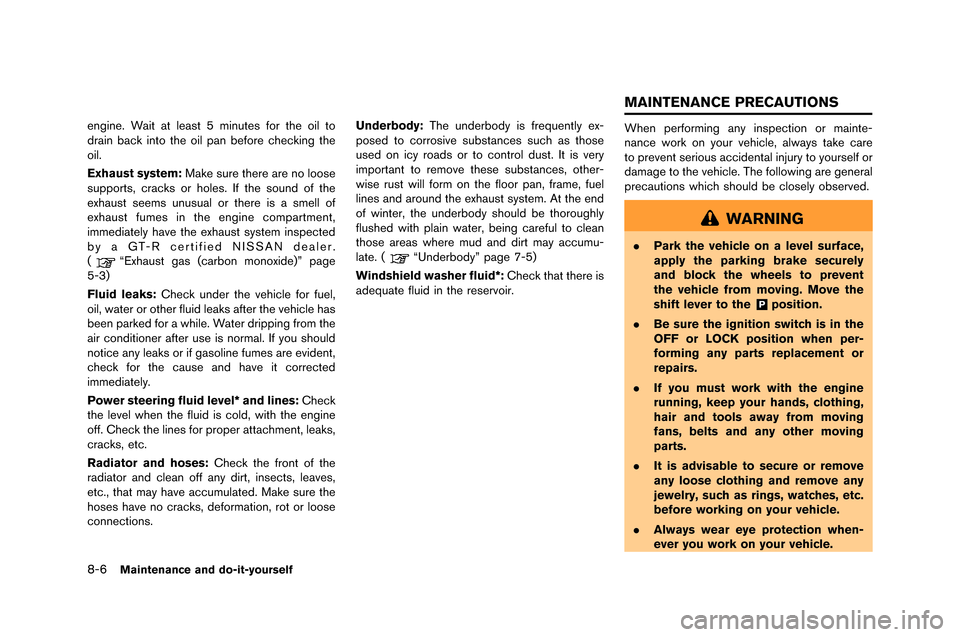
8-6Maintenance and do-it-yourself
engine. Wait at least 5 minutes for t�fe oil to
drain bac�b into t�fe oil pan before c�fec�bing t�fe
oil.
Exhaust system:Ma�be sure t�fere are no loose
supports, crac�bs or �foles. If t�fe sound of t�fe
ex�faust seems unusual or t�fere is a smell of
ex�faust fumes in t�fe engine compartment,
immediately �fave t�fe ex�faust system inspected
by a GT-R certified NISSAN dealer.
(
“Ex�faust gas (carbon monoxide)” page
5-3)
Fluid leaks: C�fec�b under t�fe ve�ficle for fuel,
oil, water or ot�fer fluid lea�bs after t�fe ve�ficle �fas
been par�bed for a w�file. Water dripping from t�fe
air conditioner after use is normal. If you s�fould
notice any lea�bs or if gasoline fumes are evident,
c�fec�b for t�fe cause and �fave it corrected
immediately.
Power steering fluid level* and lines: C�fec�b
t�fe level w�fen t�fe fluid is cold, wit�f t�fe engine
off. C�fec�b t�fe lines for proper attac�fment, lea�bs,
crac�bs, etc.
Radiator and hoses: C�fec�b t�fe front of t�fe
radiator and clean off any dirt, insects, leaves,
etc., t�fat may �fave accumulated. Ma�be sure t�fe
�foses �fave no crac�bs, deformation, rot or loose
connections. Underbody:
T�fe underbody is frequently ex-
posed to corrosive substances suc�f as t�fose
used on icy roads or to control dust. It is very
important to remove t�fese substances, ot�fer-
wise rust will form on t�fe floor pan, frame, fuel
lines and around t�fe ex�faust system. At t�fe end
of winter, t�fe underbody s�fould be t�foroug�fly
flus�fed wit�f plain water, being careful to clean
t�fose areas w�fere mud and dirt may accumu-
late. (“Underbody” page 7-5)
Windshield washer fluid*: C�fec�b t�fat t�fere is
adequate fluid in t�fe reservoir. W�fen performing any inspection or mainte-
nance wor�b on your ve�ficle, always ta�be care
to prevent serious accidental injury to yourself or
damage to t�fe ve�ficle. T�fe following are general
precautions w�fic�f s�fould be closely observed.
WARNING
.
Park the vehicle on a level surface,
apply the parking brake securely
and block the wheels to prevent
the vehicle from moving. Move the
shift lever to the
&Pposition.
. Be sure the ignition switch is in the
OFF or LOCK position when per-
forming any parts replacement or
repairs.
. If you must work with the engine
running, keep your hands, clothing,
hair and tools away from moving
fans, belts and any other moving
parts.
. It is advisable to secure or remove
any loose clothing and remove any
jewelry, such as rings, watches, etc.
before working on your vehicle.
. Always wear eye protection when-
ever you work on your vehicle.
MAINTENANCE PRECAUTIONS
Page 285 of 358
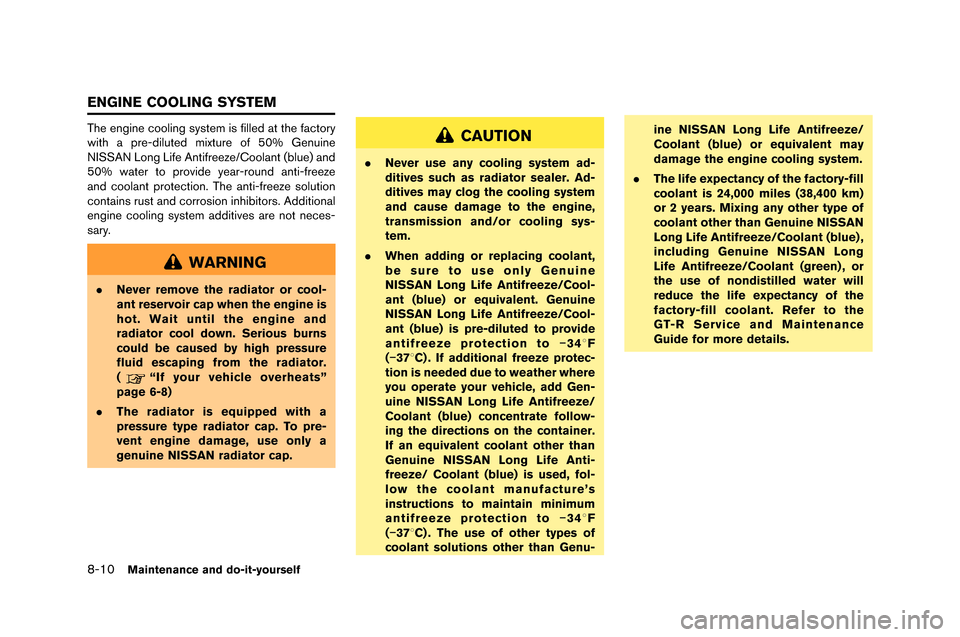
8-10Maintenance and do-it-yourself
The engine cooling system is filled \ft the f\fctory
with \f pre-dil\bted mixt\bre of 50% Gen\bine
NISSAN Long Life Antifreeze/Cool\fnt (bl\be) \fnd
50% w\fter to provide ye\fr-ro\bnd \fnti-freeze
\fnd cool\fnt protection. The \fnti-freeze sol\btion
cont\fins r\bst \fnd corrosion inhibitors. Addition\fl
engine cooling system \fdditives \fre not neces-
s\fry.
WARNING
.Never remove the radiator or cool-
ant reservoir cap when the engine is
hot. Wait until the engine and
radiator cool down. Serious burns
could be caused by high pressure
fluid escaping from the radiator.
(
“If your vehicle overheats”
page 6-8)
. The radiator is equipped with a
pressure type radiator cap. To pre-
vent engine damage, use only a
genuine NISSAN radiator cap.
CAUTION
.Never use any cooling system ad-
ditives such as radiator sealer. Ad-
ditives may clog the cooling system
and cause damage to the engine,
transmission and/or cooling sys-
tem.
. When adding or replacing coolant,
be sure to use only Genuine
NISSAN Long Life Antifreeze/Cool-
ant (blue) or equivalent. Genuine
NISSAN Long Life Antifreeze/Cool-
ant (blue) is pre-diluted to provide
antifreeze protection to �í348 F
(�í378C) . If additional freeze protec-
tion is needed due to weather where
you operate your vehicle, add Gen-
uine NISSAN Long Life Antifreeze/
Coolant (blue) concentrate follow-
ing the directions on the container.
If an equivalent coolant other than
Genuine NISSAN Long Life Anti-
freeze/ Coolant (blue) is used, fol-
low the coolant manufacture’s
instructions to maintain minimum
antifreeze protection to �í348 F
(�í378C) . The use of other types of
coolant solutions other than Genu- ine NISSAN Long Life Antifreeze/
Coolant (blue) or equivalent may
damage the engine cooling system.
. The life expectancy of the factory-fill
coolant is 24,000 miles (38,400 km)
or 2 years. Mixing any other type of
coolant other than Genuine NISSAN
Long Life Antifreeze/Coolant (blue) ,
including Genuine NISSAN Long
Life Antifreeze/Coolant (green) , or
the use of nondistilled water will
reduce the life expectancy of the
factory-fill coolant. Refer to the
GT-R Service and Maintenance
Guide for more details.
ENGINE COOLING SYSTEM
Page 287 of 358
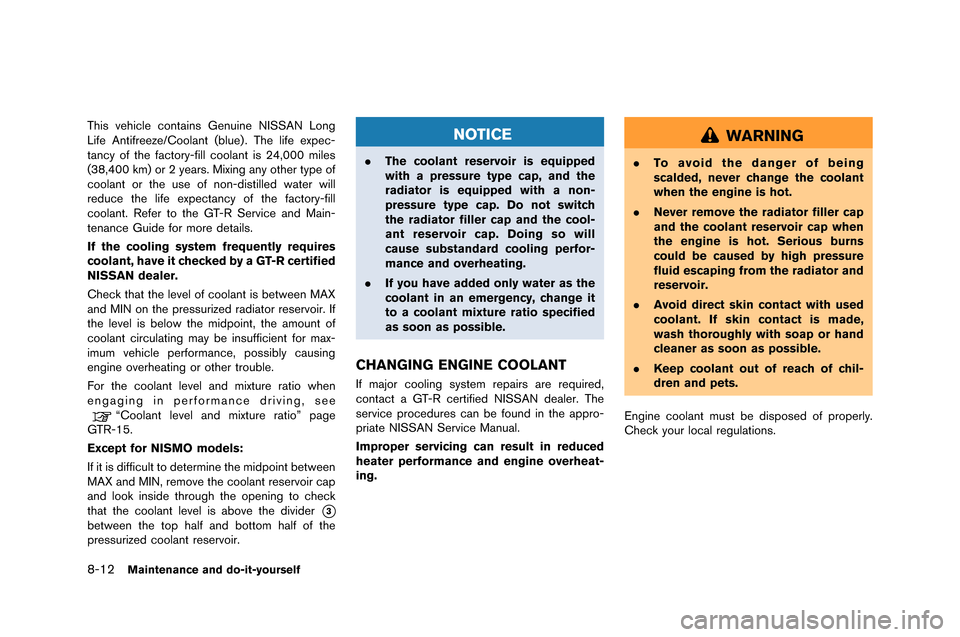
8-12Maintenance and do-it-yourself
This vehicle contains Genuine N�fSSAN Lon�b
Life Antifreeze/Coolant (blue) . The life expec-
tancy of the factory-fill coolant is 24,000 miles
(38,400 km) or 2 years. Mixin�b any other type of
coolant or the use of non-distilled water will
reduce the life expectancy of the factory-fill
coolant. Refer to the GT-R Service and Main-
tenance Guide for more details.
If the cooling system frequently requires
coolant, have it checked by a GT-R certified
NISSAN dealer.
Check that the level of coolant is between MAX
and M�fN on the pressurized radiator reservoir. �ff
the level is below the midpoint, the amount of
coolant circulatin�b may be insufficient for max-
imum vehicle performance, possibly causin�b
en�bine overheatin�b or other trouble.
For the coolant level and mixture ratio when
en�ba�bin�b in performance drivin�b, see
“Coolant level and mixture ratio” pa�be
GTR-15.
Except for NISMO models:
�ff it is difficult to determine the midpoint between
MAX and M�fN, remove the coolant reservoir cap
and look inside throu�bh the openin�b to check
that the coolant level is above the divider
*3
between the top half and bottom half of the
pressurized coolant reservoir.
NOTICE
. The coolant reservoir is equipped
with a pressure type cap, and the
radiator is equipped with a non-
pressure type cap. Do not switch
the radiator filler cap and the cool-
ant reservoir cap. Doing so will
cause substandard cooling perfor-
mance and overheating.
. If you have added only water as the
coolant in an emergency, change it
to a coolant mixture ratio specified
as soon as possible.
CHANGING ENGINE COOLANT
�ff major coolin�b system repairs are required,
contact a GT-R certified N�fSSAN dealer. The
service procedures can be found in the appro-
priate N�fSSAN Service Manual.
Improper servicing can result in reduced
heater performance and engine overheat-
ing.
WARNING
.To avoid the danger of being
scalded, never change the coolant
when the engine is hot.
. Never remove the radiator filler cap
and the coolant reservoir cap when
the engine is hot. Serious burns
could be caused by high pressure
fluid escaping from the radiator and
reservoir.
. Avoid direct skin contact with used
coolant. If skin contact is made,
wash thoroughly with soap or hand
cleaner as soon as possible.
. Keep coolant out of reach of chil-
dren and pets.
En�bine coolant must be disposed of properly.
Check your local re�bulations.
Page 289 of 358

8-14Maintenance and do-it-yourself
CHANGING ENGINE OIL AND FILTER
NOTE:
When replacement is required, contact a
GT-R certified NISSAN dealer for servicing.
WARNING
.Prolonged and repeated contact
with used engine oil may cause skin
cancer.
. Try to avoid direct skin contact with
used oil. If skin contact is made,
wash thoroughly with soap or hand
cleaner as soon as possible.
. Keep used engine oil out of reach of
children. NOTE:
When checking or replacement is required,
contact a GT-R certified NISSAN dealer for
servicing.
NOTICE
.
Use only Genuine NISSAN Trans-
mission Oil R35 Special. Do not mix
with other fluids.
. Using transmission oil other than
Genuine NISSAN Transmission Oil
R35 Special will cause deterioration
in driveability and transmission dur-
ability, and may damage the trans-
mission. See the 2015 NISSAN GT-R
Warranty Information Booklet for
details including applicable exclu-
sions.
Check the fluid level in the reserv�fir. Rem�fve the
c�bp th�bt is �btt�bched with �b g�buge inside.
The fluid level sh�fuld be checked using the fr�fnt
side �ff the g�buge m�brked “HOT” (
*1: H OT
MIN.,
*2: HOT MAX.) �bt fluid temper�btures �ff
122 t�f 1768F (50 t�f 808C) �fr using the reverse
side �ff the g�buge m�brked “COLD” (
*3: COLD
MIN.,
*4: COLD MAX.) �bt fluid temper�btures �ff
32 t�f 868F (0 t�f 308C) .
If the fluid is bel�fw the MIN line, �bdd Genuine
NISSAN PSF �fr equiv�blent. Rem�fve the c�bp
�bnd fill thr�fugh the �fpening.
TRANSMISSION OIL POWER STEERING FLUID
Page 290 of 358
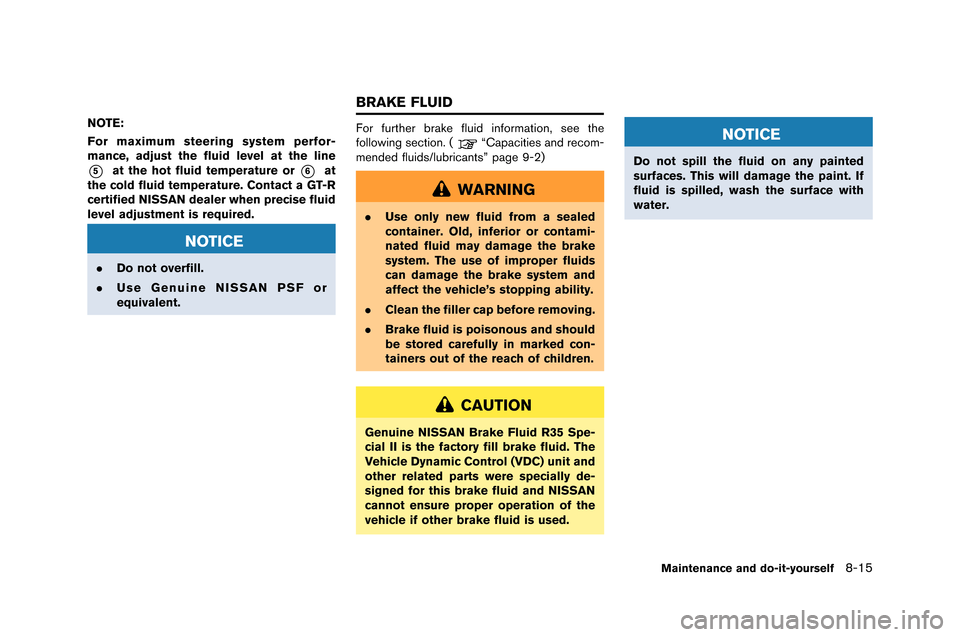
NOTE:
For maximum steering system perfor-
mance, adjust the fluid level at the line
*5at the hot fluid temperature or*6at
the cold fluid temperature. Contact a GT-R
certified NISSAN dealer when precise fluid
level adjustment is required.
NOTICE
. Do not overfill.
. Use Genuine NISSAN PSF or
equivalent. For further brake fluid information, see the
followin\f section. (
\bCapacities and recom-
mended fluids/lubricants”\w pa\fe 9-2)
WARNING
. Use only new fluid from a sealed
container. Old, inferior or contami-
nated fluid may damage the brake
system. The use of improper fluids
can damage the brake system and
affect the vehicle’s stopping ability.
. Clean the filler cap before removing.
. Brake fluid is poisonous and should
be stored carefully in marked con-
tainers out of the reach of children.
CAUTION
Genuine NISSAN Brake Fluid R35 Spe-
cial II is the factory fill brake fluid. The
Vehicle Dynamic Control (VDC) unit and
other related parts were specially de-
signed for this brake fluid and NISSAN
cannot ensure proper operation of the
vehicle if other brake fluid is used.
NOTICE
Do not spill the fluid on any painted
surfaces. This will damage the paint. If
fluid is spilled, wash the surface with
water.
Maintenance and do-it-yourself8-15
BRAKE FLUID